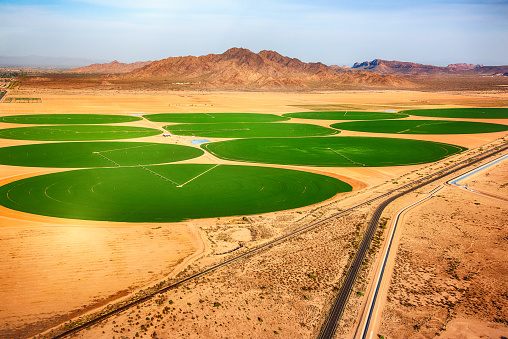Agriculture Shoulders Brunt of First Wave of Water Cuts
In 2019, states and tribes across the American West, alongside the United States and Mexican governments, signed the Drought Contingency Plan (DCP). Touted as a multi-partner agreement that would mitigate the region’s water troubles, the DCP was implemented in response to sinking water levels in Lake Powell and Lake Mead, which are fed by the Colorado River.
The objective of the DCP is to save the Colorado River system from complete collapse, mitigating the effects of the region’s megadrought on the waters which support communities ranging from California’s Central Valley, to the Phoenix valley, to northern Mexico. While it expires in 2026, its implementation significantly decreases the chances of Lake Mead sinking to critical levels in the near future.
So far, Arizona has taken the lead on conserving water resources, contributing “the equivalent of 37 feet in elevation to Lake Mead”, far more than any other agreement partner, says Terry Goddard, president of the Central Arizona Water Conservation District. That’s “far more than any other state,” he notes.
Resentment lingers among Arizona water leaders, and those soon to be affected by cuts, because of the state’s disproportionate role in conserving the mighty Colorado. California, for instance, will not be making any cuts this year, because of their seniority in the realm of water rights.
Beyond being concerned that other Western states aren’t contributing their fair share to confronting the megadrought, Arizona’s agricultural community is worried that they are being deprived of their water allocation vis-a-vis other water users within the state. And they’re right: because agricultural consumes.
Law of the River
The background of today’s fights over water is the Law of the River, a patchwork of agreements spanning back to 1922 that lays the pipework for Western water rights.
At its core, the Law of the River is a 1922 compact signed between Western states. As California boomed in the first three decades of the 20th century, neighboring states recognized the need to forge some sort of agreement regarding Colorado River water usage, so that water could be apportioned fairly.
The Colorado River Compact was forged by Colorado, Arizona, Nevada, Utah, California, New Mexico, and Wyoming in late 1922, with member states’ representatives forming the Colorado River Commission. Arizona was the last signatory, holding out until 1944.
Much of the impetus for this agreement was fear that the federal government would intervene and force an agreement that would be disadvantageous.
Arizona leaders, concerned that they weren’t getting their fair share, took their water apportionment concerns to the courts. Arizona v. California was in court for 11 years, finally being decided in Arizona’s favor in 1963. The decision expanded the federal role in managing the Colorado, interpreting the law — specifically, the Boulder Canyon Act — as “empowering the Secretary of Interior to act as water master of the Lower Colorado River, to apportion future surpluses and shortages among the states and even among users within the states.”
We can still see this dynamic at play today, with Arizona water leaders asking for federal intervention, and the Secretary of the Interior intervening to initiate water cutbacks.
Agriculture faces first cuts
The DCP, which is really made up of two agreements — the Upper Basin DCP and the Lower Basin DCP — stipulates which sectors receive less water at every “tier” of the agreement, which is tied to Lake Powell and Lake Mead’s water levels.
These amounts vary by the signatory, but in the case of Arizona, whose water apportionment from the Colorado is bound by Lake Mead’s water level, each tier is activated as the lake sinks lower:
- Tier 1: 1,075-1,050 feet — less 512,000 acre-feet of water
- Tier 2a: 1,050-1,045 feet — less 592,000 acre-feet of water
- Tier 2b: 1,045-1,025 feet — less 640,000 acre-feet of water
- Tier 3: <1,025 feet — less 720,000-acre feet of water
At each tier, Arizona receives less water from the gargantuan water source. With the federal declaration of tier 2, Arizona faces a 592,000 acre foot reduction in Colorado river water. This makes up 21% of the state’s regular water apportionment from the river.
The state has planned for reductions of water usage at each tier of drought, but these cuts aren’t affecting all Arizonans equally. Tier 1 cuts primarily impacted agriculture, and tier 2a cuts will affect agriculture further, taking water away from the Non-Indian Agricultural priority pool. Despite being originally designated for non-Tribal entities, the pool is relied on by cities, industries, and tribes for some of their agricultural output.

The agriculture community was taken aback by how quickly the state entered a tier 2 shortage, Patrick Bray, Executive Vice President at the Arizona Farm and Ranch Group, told the Tribune.
Central Valley farmers were most concerned, says Bray, that agriculture — which he mentions is a “huge economic driver” — has faced the first cuts, “while [they] continued to store water and pay others not to use their allocation.” In other words, farmers and ranchers are disgruntled that despite the compromise they’ve struck and innovation they’ve achieved on water use, they are the first on the chopping block.
“It is a few hundred farmers versus millions of residents and deep pocketbooks,” he says.
For decades, Arizona farmers and ranchers have been innovating to increase water efficiency, and now they feel they’re getting the short end of the stick.
“We have invested in seed that is more drought tolerant, compounds that help with erosion and capturing water in the soils along with sprinkler and drip systems to deliver water more effectively and efficiently to the plant,” said Bray, “If you really look back at the work agriculture has put in, we have made significant strides in our water use in a short period of time while increasing our production for the consumer.”
Now, as tier 2 cuts are set to take effect, Bray predicts decreased agricultural output and shockwaves across the consumer market.
“The ongoing water situation will no doubt cause [a] rise in food production costs along with many other factors.”
The outlook in Pinal County in particular is dim. “As conditions worsen [you’ll] likely […] see 50-60 percent of Pinal farm land fallowed this coming year,” Bray said. No matter the construction of new water infrastructure and the introduction of water-saving technologies, “the water is not available.”
Bray also points out that farms and ranches won’t simply pick up and leave, because these operations have outstanding debts and active loans for their land and equipment: “[T]he farmer is faced with a tough decision, get out or figure out how to get bigger.” This will lead to the consolidation of some farming operations, forcing previous competitors to merge for the sake of their common survival.
Farmers and ranchers across the state are already watching water prices increase, and their supply of water decrease. Dry canals and empty fields are becoming more common across the state, and many more will soon appear.
Federal dollars are being channeled towards affected farmers and ranchers, including funding for technologies that can make water use more efficient, such as drip irrigation. But that isn’t enough, say, agriculture advocates, to save the industry from the pain of water cuts. To save agriculture, there needs to be a new discussion about the balance of the state’s water portfolio, and other Western states need to do their “fair share” in conserving the Colorado, says Bray.
One point of hope for the agricultural sector, however, is that drought is temporary. Farmers and ranchers caution against creating “permanent solutions” to a temporary issue.
Of Arizona’s “Five C’s,” four are directly related to agriculture and farming: cotton, climate, citrus, and cattle. An Arizona without a strong agricultural sector is hard to imagine, but many Arizona farmers and ranchers feel they’re being asked to consider such a future. Many are holding out, like they did in the first half of the 20th century, for federal intervention that would force California and other Colorado River users to do their part in sharing the burden.
“We need to take the situation seriously, and instead of having meetings about who gets what for water allocation, we need to be looking at how we make sure Arizona gets its fair share,” says Bray.
“It is unacceptable for Arizona to continue to carry a disproportionate burden of reductions for the benefit of others who have not contributed,” said representatives of the Central Arizona Project and the Arizona Department of Water Resources in a joint statement.
*****
This article was published by The Western Tribune and is reproduced with permission.



